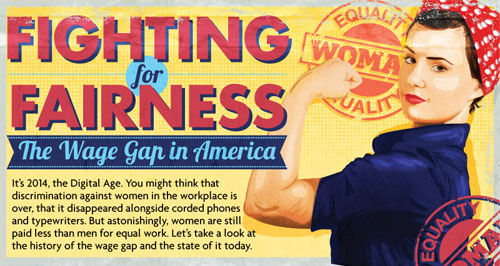
Female workers make 77 cents for every dollar that male workers make. Learn more about the wage gap in America and what’s being done about it. [1]
It’s 2014, the Digital Age. You might think that discrimination against women in the workplace is over, that it disappeared alongside corded phones and typewriters. But astonishingly, women are still paid less than men for equal work. Let’s take a look at the history of the wage gap and the state of it today.
The battle for equal pay has been fought for well over a century, but are things any better?
Yes and no. A wage gap remains, but it is getting smaller and the issue is currently in the national spotlight again with several pieces of proposed legislation.
However, today full-time female workers earn an average of only 77 cents for every dollar that their male counterparts earn, representing a gap of 23%. [1] If you break this figure down, that means that in a year, a full-time female worker loses $5,000 in wages due to this inequality. The total wages lost by the average female worker aged 65 years and older comes to a staggering $431,000. [2] And this is a disturbing difference, particularly considering the fact that women are the primary breadwinners in 50% of the nation’s households. [2]
At the same time, some people dispute the difference, claiming they don’t buy into the wage gap. They think the difference in women’s pay is brought about by factors other than discrimination. According to these dissenters the wage gap can be explained by the amount of work performed by women versus that of men. A time use survey done by the Department of Labor shows that men work an average of only 5% longer than women. [3]
So what is being done to finally put an end to this inequality?
The Equal Pay Act: Passed in 1963, this act was the first to declare equal pay for equal work.
Title VII, Under the Civil Rights Act: This act, passed by Congress in 1964 still allows women to file claims that go directly to court regarding pay discrimination. [4]
The Lilly Ledbetter Fair Pay Act: This law makes it possible for women to file complaints regarding an unfairness in pay 180 days after a discriminatory paycheck is issued. [1]
Executive Order 11246: This order prohibits federal contractors from discriminating in employment decisions based on gender regarding practices such as pay, raises and promotions. [5]
SOURCES:
- http://www.iwpr.org
- http://www.whitehouse.gov
- http://www.forbes.com
- http://www.eeoc.gov
- http://www.dol.gov
ADDITIONAL SOURCES:
Enjoy and share this informative information, courtesy of Infographic World.


You must be logged in to post a comment Login